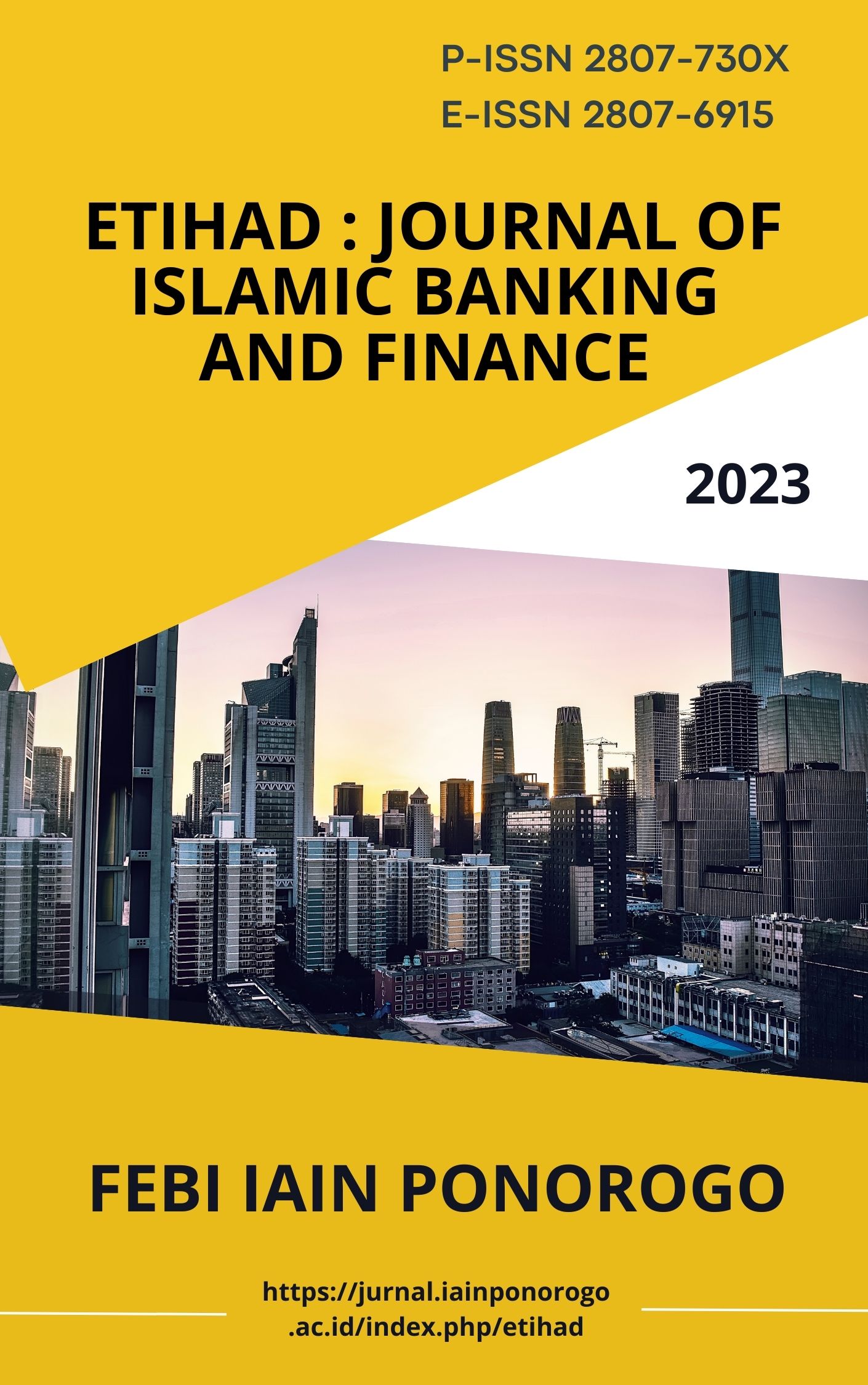Islamic Financial Inclusion and Economic Growth: a case study in East Kalimantan
DOI:
https://doi.org/10.21154/etihad.v3i2.7559Keywords:
Islamic Financial Inclusion, Economic Growth, VECMAbstract
Introduction: Stability in the financial system is a component that can stimulate economic expansion. However, this cannot be accomplished if only a minority of the population has access to the financial system's intermediation function. This may be due to a lack of access, information, or even public awareness of the use of financial services. The objective of this study is to ascertain the extent of inclusivity in East Kalimantan and examine how it influences the region's economic development. Therefore, financial inclusion plays a crucial role in fostering economic expansion by establishing stable financial conditions. Research Methods: The Vector Error Correction Model is applied to analyze data obtained from Sharia Banking Statistics (SPS OJK) and Central Statistics Agency (BPS) publications, in addition to other corroborating sources, for the purpose of this quantitative study. Results: The research findings indicate that the degree of Islamic financial inclusion in East Kalimantan was low in 2017 and 2018, but reached a high level in 2019, 2020, and 2021. Conclusion: The immediate impact of Islamic financial inclusion on economic growth in East Kalimantan is substantial. Nevertheless, over the 2017-2021 period, there is no substantial impact on the level of Islamic financial inclusion and economic growth in East Kalimantan in the long run.References
Adzimatinur, F., & Manalu, V. G. (2021). The Effect of Islamic Financial Inclusion on Economic Growth: A Case Study of Islamic Banking in Indonesia. Budapest International Research and Critics Institute (BIRCI-Journal): Humanities and Social Sciences, 4(1), 976”“985.
Ahmad, M., Majeed, A., Khan, M. A., Sohaib, M., & Shehzad, K. (2021). Digital financial inclusion and economic growth: Provincial data analysis of China. China Economic Journal, 14(3), 291”“310. https://doi.org/10.1080/17538963.2021.1882064
Anindyntha, F. A. (2020). Pengaruh Penerapan Inklusi Keuangan terhadap Pertumbuhan Ekonomi di Indonesia. Jurnal Ilmu Ekonomi, 4(1), 153”“164.
Anwar, A., Uppun, P., Reviane, I., & Reviani, A. (2016). The Role of Financial Inclusion to Poverty Reduction in Indonesia. International Organization of Scientific Research Journal of Business and Management, 18, 37”“39. https://doi.org/10.9790/487X-1806033739
Bashir, A.-H. M. (2018). Reducing poverty and income inequalities: Current approaches and Islamic perspective. Journal of King Abdulaziz University: Islamic Economics, 31(1).
Chinoda, T., & Kapingura, F. M. (2023). Digital financial inclusion and economic growth in Sub-Saharan Africa: The role of institutions and governance. African Journal of Economic and Management Studies, ahead-of-print(ahead-of-print). https://doi.org/10.1108/AJEMS-09-2022-0372
Frita, N., Hamdani, I., & Devi, A. (2021). Pengaruh Inklusi Keuangan dan Bank Syariah terhadap Infrastruktur Nasional Dan Pertumbuhan Ekonomi Dalam Program SDGs. El-Mal: Jurnal Kajian Ekonomi & Bisnis Islam, 5(1), 155”“182. https://doi.org/10.47467/elmal.v5i1.690
IPDRB 34 Provinsi di Indonesia pada 2018 | Databoks. (2021). https://databoks.katadata.co.id/datapublish/2019/07/31/inilah-pdrb-34-provinsi-di-indonesia-pada-2018
Iramayasari, I., & Adry, M. R. (2020). Pengaruh Inklusi Keuangan Terhadap Stabilitas Sistem Keuangan dan pertumbuhan Ekonomi di ASEAN. Jurnal Kajian Ekonomi Dan Pembangunan, 2(2), 29”“38.
Mandira Sarma. (2012). Index of Financial Inclusion ”“ A measure of financial sector inclusiveness. Berlin Working Papers on Money, Finance, Trade and Development, 07.
Mohieldin, M., Rostom, A., Mohieldin, M., Fu, X., & Iqbal, Z. (2011). The role of Islamic finance in enhancing financial inclusion in Organization of Islamic Cooperation (OIC) countries. World Bank Washington, DC.
Murtadlo, K., & Sulhan, M. (2023). Ekonomi Digital dan Inklusi Keuangan Terhadap Pemulihan Ekonomi Nasional. Jurnal Nusantara Aplikasi Manajemen Bisnis, 8(1), 90”“104.
Ozili, P. K. (2021). Financial inclusion research around the world: A review. Forum for Social Economics, 50(4), 457”“479.
Rachmanto, G. A. (2023). Inklusi keuangan dan pertumbuhan ekonomi pada negara-negara ASEAN. https://repository.unpar.ac.id/handle/123456789/16317
Ruocco, V. (2021). Overcoming poverty: A philosophical inquiry.
Sarma, M. (2015). Measuring financial inclusion. Economics Bulletin, 35(1), 604”“611.
Sethi, D., & Acharya, D. (2018). Financial inclusion and economic growth linkage: Some cross country evidence. Journal of Financial Economic Policy, 10(3), 369”“385. https://doi.org/10.1108/JFEP-11-2016-0073
Sharma, D. (2016). Nexus between financial inclusion and economic growth: Evidence from the emerging Indian economy. Journal of Financial Economic Policy, 8(1), 13”“36. https://doi.org/10.1108/JFEP-01-2015-0004
Takyi, P. O., Sakyi, D., Yusif, H., Asante, G. N., Osei-Fosu, A. K., & Mensah, G. (2023). Financial inclusion and financial development: Implications for monetary policy effectiveness and economic growth in sub-Saharan Africa. Journal of Economic and Administrative Sciences, ahead-of-print(ahead-of-print). https://doi.org/10.1108/JEAS-09-2022-0215
Umar, A. I. (2017). INDEX OF SYARIAH FINANCIAL INCLUSION IN INDONESIA. Buletin Ekonomi Moneter Dan Perbankan, 20(1), 99”“126. https://doi.org/10.21098/bemp.v20i1.726
Urutan Provinsi Terluas di Indonesia | Databoks. (2021). https://databoks.katadata.co.id/datapublish/2018/01/16/perbandingan-luas-wilayah-provinsi-indonesia
Van, L. T.-H., Vo, A. T., Nguyen, N. T., & Vo, D. H. (2021). Financial inclusion and economic growth: An international evidence. Emerging Markets Finance and Trade, 57(1), 239”“263.
Wijekoon, R., Sabri, M. F., & Paim, L. (2021). Poverty: A Literature Review of the Concept, Measurements, Causes and the Way Forward. Social Sciences, 11(15), 93”“111.
Yuliani, E. (2020). Dampak keuangan inklusif terhadap pertumbuhan ekonomi: Penggunaan data panel level provinsi di Indonesia. Musamus Journal of Economics Development, 3(1), 44”“56.
Downloads
Published
Issue
Section
License
Copyright (c) 2025 Fitria Rahmah

This work is licensed under a Creative Commons Attribution-NonCommercial 4.0 International License.
Etihad: Journal of Islamic Banking and Finance allow the author(s) to hold the copyright without restrictions and allow the author(s) to retain publishing rights without restrictions, also the owner of the commercial rights to the article is the author.







